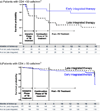Integration of antiretroviral therapy with tuberculosis treatment
- PMID: 22010915
- PMCID: PMC3233684
- DOI: 10.1056/NEJMoa1014181
Integration of antiretroviral therapy with tuberculosis treatment
Abstract
Background: We previously reported that integrating antiretroviral therapy (ART) with tuberculosis treatment reduces mortality. However, the timing for the initiation of ART during tuberculosis treatment remains unresolved.
Methods: We conducted a three-group, open-label, randomized, controlled trial in South Africa involving 642 ambulatory patients, all with tuberculosis (confirmed by a positive sputum smear for acid-fast bacilli), human immunodeficiency virus infection, and a CD4+ T-cell count of less than 500 per cubic millimeter. Findings in the earlier-ART group (ART initiated within 4 weeks after the start of tuberculosis treatment, 214 patients) and later-ART group (ART initiated during the first 4 weeks of the continuation phase of tuberculosis treatment, 215 patients) are presented here.
Results: At baseline, the median CD4+ T-cell count was 150 per cubic millimeter, and the median viral load was 161,000 copies per milliliter, with no significant differences between the two groups. The incidence rate of the acquired immunodeficiency syndrome (AIDS) or death was 6.9 cases per 100 person-years in the earlier-ART group (18 cases) as compared with 7.8 per 100 person-years in the later-ART group (19 cases) (incidence-rate ratio, 0.89; 95% confidence interval [CI], 0.44 to 1.79; P=0.73). However, among patients with CD4+ T-cell counts of less than 50 per cubic millimeter, the incidence rates of AIDS or death were 8.5 and 26.3 cases per 100 person-years, respectively (incidence-rate ratio, 0.32; 95% CI, 0.07 to 1.13; P=0.06). The incidence rates of the immune reconstitution inflammatory syndrome (IRIS) were 20.1 and 7.7 cases per 100 person-years, respectively (incidence-rate ratio, 2.62; 95% CI, 1.48 to 4.82; P<0.001). Adverse events requiring a switching of antiretroviral drugs occurred in 10 patients in the earlier-ART group and 1 patient in the later-ART group (P=0.006).
Conclusions: Early initiation of ART in patients with CD4+ T-cell counts of less than 50 per cubic millimeter increased AIDS-free survival. Deferral of the initiation of ART to the first 4 weeks of the continuation phase of tuberculosis therapy in those with higher CD4+ T-cell counts reduced the risks of IRIS and other adverse events related to ART without increasing the risk of AIDS or death. (Funded by the U.S. President's Emergency Plan for AIDS Relief and others; SAPIT ClinicalTrials.gov number, NCT00398996.).
Conflict of interest statement
Author disclosure:
Dr. S. Abdool Karim reports being listed as a coinventor on two patents (2000/3437 and PCT/IB02/04550) that are part of the development of clade C HIV vaccines; and Mr. Gray, receiving lecture fees from AstraZeneca, Aspen Pharmacare, and Fresenius Kabi. No other potential conflict of interest relevant to this article was reported.
Figures
Comment in
-
When to start antiretroviral therapy in HIV-associated tuberculosis.N Engl J Med. 2011 Oct 20;365(16):1538-40. doi: 10.1056/NEJMe1109546. N Engl J Med. 2011. PMID: 22010921 No abstract available.
-
Timing of antiretroviral therapy for HIV-1-associated tuberculosis.N Engl J Med. 2012 Feb 2;366(5):474; author reply 475-6. doi: 10.1056/NEJMc1113986. N Engl J Med. 2012. PMID: 22296084 No abstract available.
References
-
- Fishman JE, Saraf-Lavi E, Narita M, Hollender ES, Ramsinghani R, Ashkin D. Pulmonary tuberculosis in AIDS participants: transient chest radiographic worsening after initiation of antiretroviral therapy. Am J Roentgenol. 2000;174:43–49. - PubMed
- Chien JW, Johnson JL. Paradoxical reactions in HIV and pulmonary TB. Chest. 1998;114:933–936. - PubMed
-
- Girardi E, Palmieri F, Cingolani A, et al. Changing clinical presentation and survival in HIV-associated tuberculosis after highly active antiretroviral therapy. Journal of acquired immune deficiency syndromes. 2001;26:326–331. - PubMed
-
- Lalloo UG. Efavirenz and nevirapine interactions with rifampicin: resolving the dilemmas? Clin Infect Dis. 2009;48:1760–1762. - PubMed
Publication types
MeSH terms
Substances
Associated data
Grants and funding
LinkOut - more resources
Full Text Sources
Other Literature Sources
Medical
Research Materials


